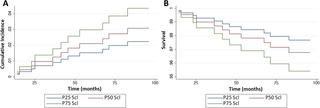PLOS ONE ( IF 3.7 ) Pub Date : 2018-06-21 , DOI: 10.1371/journal.pone.0199504 Cristina Novo-Rodríguez , Beatriz García-Fontana , Juan De Dios Luna-Del Castillo , Francisco Andújar-Vera , Verónica Ávila-Rubio , Cristina García-Fontana , Sonia Morales-Santana , Pedro Rozas-Moreno , Manuel Muñoz-Torres

|
Cardiovascular diseases are a health problem throughout the world, especially in people with diabetes. The identification of cardiovascular disease biomarkers can improve risk stratification. Sclerostin is a modulator of the Wnt/β-catenin signalling pathway in different tissues, and it has recently been linked to vascular biology. The current study aimed to evaluate the relationship between circulating sclerostin levels and cardiovascular and non-cardiovascular mortality in individuals with and without type 2 diabetes. We followed up a cohort of 130 participants (mean age 56.8 years; 48.5% females; 75 with type 2 diabetes; 46 with prevalent cardiovascular disease) in which serum sclerostin levels were measured at the baseline. Time to death (both of cardiovascular and non-cardiovascular causes) was assessed to establish the relationship between sclerostin and mortality. We found that serum sclerostin concentrations were significantly higher in patients with prevalent cardiovascular disease (p<0.001), and independently associated with cardiovascular mortality (p = 0.008), showing sclerostin to be a stronger predictor of mortality than other classical risk factors (area under the curve = 0.849 vs 0.823). The survival analysis showed that an increase of 10 pmol/L in the serum sclerostin level resulted in a 31% increase in cardiovascular mortality. However, no significant association was observed between sclerostin levels and non-cardiovascular mortality (p = 0.346).
From these results, we conclude that high sclerostin levels are related to mortality due to cardiovascular causes. The clinical implication of these findings is based on the possible use of serum sclerostin as a new biomarker of cardiovascular mortality risk in order to establish preventive strategies.
中文翻译:

硬化素的循环水平与心血管疾病的死亡率有关
心血管疾病是全世界的健康问题,尤其是在糖尿病患者中。心血管疾病生物标志物的鉴定可以改善风险分层。硬化蛋白是不同组织中Wnt /β-catenin信号传导途径的调节剂,最近已与血管生物学联系起来。当前的研究旨在评估患有和不患有2型糖尿病的个体中循环硬化素水平与心血管和非心血管死亡率之间的关系。我们对130名参与者(平均年龄56.8岁;女性48.5%; 75名患有2型糖尿病; 46名患有普遍的心血管疾病)的参与者进行了随访,在基线时测量了血清硬化素水平。评估死亡时间(心血管原因和非心血管原因)以建立硬化素与死亡率之间的关系。我们发现,患有心血管疾病的患者的血清硬化素浓度显着较高(p <0.001),并且与心血管疾病死亡率独立相关(p = 0.008),表明硬化素是死亡率的更强预测因子(曲线下面积= 0.849 vs 0.823)。生存分析表明,血清硬化素水平增加10 pmol / L可使心血管死亡率增加31%。然而,在硬化素水平和非心血管疾病死亡率之间未发现显着相关性(p = 0.346)。
从这些结果,我们得出结论,高硬化蛋白水平与心血管原因导致的死亡率有关。这些发现的临床意义是基于可能使用血清硬化素作为心血管死亡风险的新生物标记,以建立预防策略。



























 京公网安备 11010802027423号
京公网安备 11010802027423号